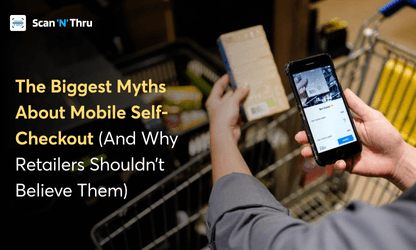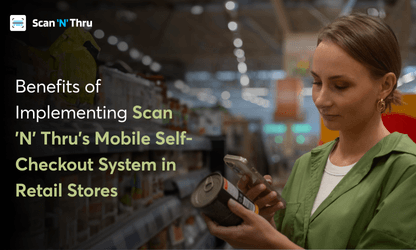A January 2024 study from NCR Voyix stated that 43% of consumers expressed their preference for self-checkout over traditional checkouts.
So why this surge in popularity? It's simple: speed, shorter lines, and privacy.
"Self-checkout is evolving to offer a quicker and more user-friendly experience," says David Wilkinson, CEO of NCR Voyix, in the same study. He accurately captures the situation when he adds, "The reality is shoppers want more control over their checkout experience, and self-checkout delivers that flexibility."
Now for retailers like you, all of it matters. If you are grappling with long wait times, operational efficiency, labor costs, and customer satisfaction, then retail store self-checkout can prove to be a turning point for you.
With the increased adoption of this technology by more retailers, a key question still lingers: How do you effectively implement self-checkout into your retail operations?
This blog will lead you through various necessary elements for a seamless transition that pleases your customers and increases your profits. Are you ready to take some notes?
Let's begin by understanding why retailers like you need a self-checkout system.
Why do you need a self-checkout system?
Convenience and speed - that’s what today’s shoppers care about most. A report titled ‘Global study on self-checkout in retail’ published in 2022 by ECR Retail Loss revealed that 96% of grocery and 77% of non-grocery retailers offered some form of self-checkout system.
This means many consumers are accustomed to this quick and hassle-free technology in their daily lives, and they expect their shopping experience to remain consistent. Self-checkout systems cater to this demand by offering customers control over their purchase process and reducing wait times. Hence, if you’re among those retailers who do have this technology in place, then you’re surely missing out.
Addressing common challenges with self-checkout systems

For retailers like you, retail self-checkout technology can significantly cut labor costs and improve operational efficiency. Apart from that, these systems allow your staff to focus on other important tasks like restocking shelves, assisting customers, and maintaining the store. Lastly, this technology also helps you handle rush hours more effectively as it reduces the need for additional staff during peak times.
It’s clear now what self-checkout solutions can do for your business. Now let’s explore what you need to consider for successful implementation of these systems.
Assessing the readiness of your retail store
Before you dive into the self-checkout implementation, first, it's essential to evaluate your store's specific requirements.
You should consider factors like:
- Your store size
- Customer volume
- Peak hours
For instance, if you own a small boutique shop, then just one or two self-checkout kiosks will be enough for your store. However, you will need a more extensive setup if you have a large supermarket.
Identify the key challenges your store faces. Ask yourself questions like:
- Are long queues a common issue?
- Do you struggle with high labor costs?
- Is your current store layout optimized for peak shopping hours?
Knowing and understanding these pain points will help you choose the right self-checkout solution for your store.
After that, you need to identify which features are the most important for your retail niche. Certain stores may require only fundamental self-service checkout capabilities, whereas others could find value in more advanced options such as mobile checkout, NFC payments, or QR code scanning.
Choosing the right self-checkout technology
Whenever there’s a need to implement any technology, the software and hardware considerations become unavoidable. Self-checkout solutions are no exception.
Selecting the right hardware and software is essential for a self-checkout system to be successful. To do that, you need to:
i) Search for machines and scanners that are robust so that they can handle your store’s traffic and,
ii) Make sure that the software is reliable, safe, and simple to upgrade.
Besides, user-friendly design is paramount. An intuitive interface will boost customer adoption and minimize frustration. To achieve that, you should consider systems that offer clear instructions and visual cues to guide your customers through the checkout process.
Customization options are also important. Your chosen system should adapt to your store's layout, product categories, and customer preferences. Some self-checkout software allows for personalized branding, which can help maintain a consistent shopping experience.
Therefore, when you select a vendor, you should prioritize those who offer comprehensive support and maintenance services. A reliable provider will ensure your system runs smoothly and help you tackle any issues that arise.
At this point, your store will be ready with the self-service checkout system. Next, it’s time to prepare your staff and introduce it to your customers.
Preparing your staff for the transition
Effective training of your staff members is crucial after the successful implementation of your self-checkout system. Your employees need to be well-versed in helping customers, fixing common problems, and carrying out simple maintenance tasks on the equipment.
You can think about forming a specialized group of "self-checkout specialists" to offer additional assistance during the initial stage of implementation.
Familiarizing your customers with the new system
For your customers, clear guidance is essential. For this, you should create easy-to-understand signage and instructional videos to walk them through the self-checkout process. Then, place these materials strategically around the checkout area for quick reference.
To encourage the adoption of a self-checkout system among your customers, you should offer incentives for first-time users or any promotional offers. Small discounts or extra loyalty points often motivate customers to try the new system. The more they use the system, the more familiar they will get with it. Monitoring performance and making improvements
Monitoring performance and making improvements

Keeping your self-checkout system running smoothly is essential, and you can only do so with regular maintenance. Now, to make sure that happens, you should establish regular inspections and maintenance to guarantee both hardware and software are operating at their best.
Moreover, you should actively seek feedback from your customers and staff as well. Their observations can assist you in pinpointing areas of dissatisfaction and opportunities for enhancement. You can utilize surveys, suggestion boxes, or casual discussions to collect this valuable data.
After that, you have to analyze sales data and system analytics to identify areas for improvement. Look for patterns in checkout times, common errors, or underutilized features. Use this data to make informed decisions about optimizing your self-checkout experience.
Market your self-checkout to your customers
Effectively marketing your new self-checkout solution can greatly influence its success. You can do that by emphasizing the advantages for your customers, like:
-
Quicker payment processing
-
Shorter wait times
-
Availability of contactless payment methods
In addition to that, you can utilize in-store signs, social media, and email updates to promote your new and convenient checkout option.
You can also consider running special promotions to encourage usage. Offer small discounts or bonus rewards for customers who use self-checkout during the first few months of implementation. This can help create positive associations with the new system and drive adoption.
Ensure the scalability of your self-checkout solution
Always explore the possibility of future expansion when setting up a self-service checkout system. Select an option that has the ability to expand along with your company's growth. Your system needs to be able to easily incorporate new units as your store grows or your customer traffic rises.
Furthermore, take into account the system's ability to incorporate upcoming technologies. As AI and ML progress further, your self-checkout system must be flexible to integrate these advancements. It will keep your store ahead of the game.
Also Read - A Quick and Easy Guide to Grocery Store Self-Checkout
Conclusion
Effectively installing self-service checkout in your store demands thorough preparation. You are now aware that you can establish a smooth and effective checkout process by:
-
Evaluating your requirements
-
Choosing the appropriate solution
-
Educating your staff and customers
-
Continuously optimizing
-
Guaranteeing expandability
-
Efficiently promoting the system
Keep in mind that self-checkout is an investment in both efficiency and customer satisfaction. With the retail sector evolving continuously, utilizing cutting-edge solutions such as self-checkout technology helps your business stand out.
So, don’t take too long to acknowledge the potential of this technology and think about how it can be incorporated into your retail activities.
And if you’re wondering which self-checkout solution will be easier to implement as discussed in the blog, then it’s Scan ‘N’ Thru. It offers everything necessary to transform how you process payments and increase sales.
On top of that, if you have any questions regarding the implementation of this tool into your retail business, our experts are ready to provide guidance and equip you with knowledge so that you can arrive at a decision.
So, why wait? Explore Scan ‘N’ Thru self-checkout solution for your retail establishment now and initiate the process towards a more effective and customer-focused tomorrow.




